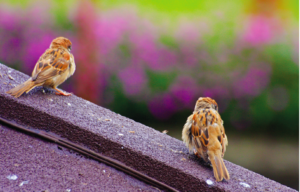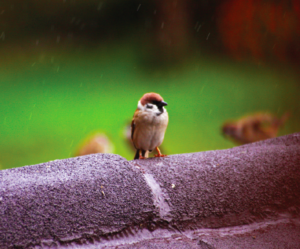We think it’s our national bird, but it’s not.
These birds are ubiquitous, particularly in Metro Manila and in major provinces across the Philippines. These little round bundles of brown feathers are in our backyards, on the busy streets, perched on electric and telephone wires. No wonder they’re our national bird, you may think. But they’re not our national bird anymore; that honor belongs to the gorgeous Philippine Eagle. What’s more, there may be no real mayas left in Metro Manila.
Who’s Who?

The “real” maya is, according to Wikipedia, known as the Black-headed or Chestnut Munia (Lonchuria atricapilla). Other names include “mayang pula” (red maya), chestnut mannikin, black-headed nun, black-headed mannikin, and black hooded nun. If you’ve ever wondered why descriptions of the maya seem more colorful in articles and writings published before World War II, it’s because the real maya does have a richer, redder color scheme to its feathers. The maya “impostor” is the Eurasian tree sparrow (Passer montanus), and the Wild Bird Club of the Philippines has deemed it “the most abundant and visible bird” in Metro Manila.
In its blog, the club explains that the Eurasian Tree Sparrow was successfully introduced to the country. Found over Europe and Asia, particularly Southeast Asia, the Eurasian Tree Sparrow looks the same everywhere it nests.
Wikipedia gives its length as being from 12.5–14 centimeters (cm), with a wingspan of about 21 cm. Normally weighing in at 24 grams, it tends to be a compact little animal, with a grayish blue bill. It can feed upon seeds and grain, and likes weed seeds, such as chickweeds and goosefoot; it can also feed upon peanuts. Surprisingly, it has no compunctions about eating insects such as woodlice, millipedes, centipedes, spiders, and harvestmen. The Eurasian tree sparrow reaches sexual maturity within a year, and will choose to build nests in recessed areas such as tree cavities or under the eaves of a house. It can even recycle nests abandoned by bigger birds.
Save the Impostor!

The Eurasian tree sparrow’s high survival rate and quick multiplication can perhaps be attributed to its ability to forage for food other than the seeds and grains that form its normal diet, and adaptability to urban conditions. Environmental scientist Dr. Benjamin Vallejo wrote in his blog that the Eurasian tree sparrow “…has modified its behavior and life history to exploit human habitations.
Where humans build their houses, the birds thrive.” But this cute little bird is declining in numbers; in the United Kingdom, there are calls to put it on the endangered species list. Dr. Vallejo estimates that in 2010, the Eurasian tree sparrow population had declined by about 30-40% since 2005, and that one possible reason for their decline was the sheer number of skyscraper developments in Metro Manila, particularly in Makati City. Another potential reason could be the increasingly hot and humid temperatures in Metro Manila.
Photos by Bernadette Luna
This appeared without a byline as “The Cutest Impostor” in Animal Scene’s September 2015 issue.






